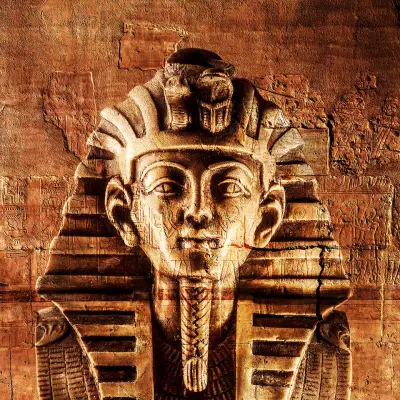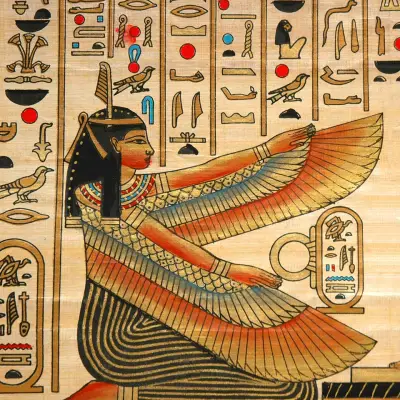Many people are first drawn to Inari out of curiosity about Japan’s famous fox spirits or after visiting the breathtaking red torii gates at Kyoto’s Fushimi Inari Shrine. Whether you’re fascinated by folklore, interested in Shinto beliefs, or simply love learning about unique deities, exploring the stories and symbolism surrounding Inari can be fascinating.
This blog post explores Inari – the Japanese god or goddess (or both!) of rice, prosperity, and foxes – and examines what makes this shapeshifting figure one of the most beloved in Japanese culture.
Jump to:
- Who Is Inari in Japanese Mythology?
- Inari’s Myths
- The Role of Inari in Japanese Storytelling
- What Powers Did Inari Possess?
- Symbols Associated with Inari
- Inari's Lineage and Connections
- Why Is Inari Special?
- Inari in Modern Culture
- Inari's Worship and Legacy
- Frequently Asked Questions
- Study Japanese Mythology for £29
Recommended for you!
Best SellersWho Is Inari in Japanese Mythology?
Inari is a prominent deity in Japan, particularly within the Shinto tradition, associated with agriculture, fertility, prosperity, and business success. While many deities in mythology are fixed in form and identity, Inari stands out for being fluid in gender and manifestation. At times, Inari is depicted as a beautiful woman, other times as an elderly man or a youthful figure – even as a collective of three or five spirits.
This flexibility reflects Inari’s many roles across Japanese society, from guardian of the rice fields to divine patron of merchants, swordsmiths, and blacksmiths. Their popularity has endured for over a thousand years, and they are worshipped at tens of thousands of shrines throughout Japan.
Inari’s Myths

The stories of Inari are as diverse and adaptable as the deity themselves. Passed down through generations and shaped by local traditions, these myths offer insight into Inari’s role in Japanese life and spirituality:
The White Fox and the Rice Fields
One popular myth tells of Inari descending from the mountains, riding a white fox to help impoverished farmers. They taught the villagers how to grow rice, saving them from famine and earning them a reputation as a generous provider.
Inari and Ukanomitama
Another story connects Inari with Ukanomitama, the Shinto kami of food and agriculture. In some versions, Inari is said to be a form of Ukanomitama or their divine partner, reflecting the deity’s close ties to nourishment and survival.
The Blend of Shinto and Buddhist Belief
Over time, Inari’s image was shaped by both Shinto and Buddhist influences. In Buddhist traditions, Inari is sometimes linked to Dakiniten, a powerful figure who also rides a fox and embodies spiritual insight, adding new layers to Inari’s identity.
The Role of Inari in Japanese Storytelling
Inari’s role goes beyond agriculture. As Japan’s society evolved, Inari’s influence expanded into commerce and craftsmanship. During the Edo period, merchants especially venerated Inari, praying for profitable business and good fortune. Swordsmiths also prayed to Inari for precision and strength in their work.
In literature and theatre, Inari often appears as a mysterious helper or protector. They are closely linked to the kitsune – supernatural fox spirits – who can serve as both messengers and manifestations of Inari. These fox spirits are seen as clever, magical beings capable of shape-shifting, often acting as guides or tricksters in traditional stories.
What Powers Did Inari Possess?

Inari’s powers are primarily rooted in nurturing and sustaining life. As gods of rice, the staple of Japanese food and culture, Inari controls agricultural fertility, harvests, and abundance. They are also credited with bestowing wealth, success, and creative inspiration, especially in industries tied to metalwork and trade. Their powers include:
- Shape-shifting: Inari themselves may change form, often appearing as a fox or human depending on the need or occasion.
- Control over fertility and harvests: Inari can bless crops and livestock, ensuring plentiful yields and healthy communities.
- Influence over prosperity: Many believe Inari can help people and businesses thrive financially, which is why shopkeepers and entrepreneurs often honour them.
Symbols Associated with Inari

Perhaps the most iconic symbols of Inari are the red torii gates leading to their shrines, especially the seemingly endless paths at Fushimi Inari-taisha in Kyoto. But Inari’s symbolism goes much deeper.
- Foxes (kitsune): Although not Inari themselves, these Inari fox animals are considered sacred messengers or even avatars of the deity. You’ll often see stone fox statues holding rice keys or scrolls in their mouths at Inari shrines.
- Rice and sheaves: Representing abundance and sustenance.
- White: One of the colours of Inari, symbolising purity and divinity. The foxes associated with Inari are often imagined as white to reflect this.
- Flames or jewels: Occasionally, Inari foxes are shown carrying glowing orbs or flames, symbolising wisdom and spiritual power.
Inari's Lineage and Connections
Inari’s exact lineage is debated and varies across regions. As mentioned, they are often equated with Ukanomitama, a Shinto kami associated with food. In Buddhist contexts, Inari is sometimes linked to Dakiniten, a goddess of esoteric Buddhism who rides a white fox and carries a flaming jewel.
This blending of Shinto and Buddhist influences is characteristic of Japanese spirituality, where religious figures and meanings frequently overlap. As such, Inari is a deity of many faces, equally revered by farmers, monks, artisans, and shopkeepers.
Why Is Inari Special?
What makes Inari truly unique is their accessibility and presence in everyday life. While some deities are distant or abstract, Inari is felt to be close, approachable and willing to help with practical concerns like feeding a family or running a business.
They are also one of the few deities to maintain immense popularity across centuries. Their shrines are often built near homes, businesses, and rice fields, showing how deeply embedded Inari is in Japanese daily life.
Inari in Modern Culture

Inari continues to influence Japanese art, anime, films, and games. You may have seen references in Studio Ghibli’s Spirited Away or video games like Ōkami. The image of the fox god, often a white fox with red markings, is now iconic and instantly recognisable.
Modern visitors to Japan are often fascinated by the Inari, especially when encountering the mystical atmosphere of Fushimi Inari Shrine, with its forested trails, lanterns, and fox statues. Inari’s enduring presence shows how mythology continues to inspire and enchant people today.
Inari's Worship and Legacy
There are over 30,000 Inari shrines in Japan, making Inari one of the most worshipped deities in the country. The most famous is Fushimi Inari-taisha, but smaller shrines exist in nearly every city, town, and rural community. If you're planning to visit an Inari shrine, here are a few pointers for how to pray:
- Bow at the torii gate before entering the sacred space.
- Clean your hands and mouth at the purification basin.
- Approach the main hall, toss a coin into the offering box, bow twice, clap twice, make your prayer, and bow once more.
- Leave respectfully, avoiding loud conversation or disruptive behaviour.
People often leave offerings of:
- Rice or sake, symbolising gratitude for food and prosperity.
- Fried tofu (aburaage) – a favourite of the Inari fox spirit, believed to please them greatly.
- Candles and incense, for spiritual connection.
These offerings show thanks and invite continued blessings from the deity.
Recommended for you!
Best SellersFrequently Asked Questions
What is Inari the goddess of?
Inari is associated with rice, agriculture, prosperity, and fertility. While sometimes referred to as a goddess, Inari is often gender-fluid and appears in many forms. Their divine role also includes protecting businesses and craftsmen.
What is the meaning of Inari shrine?
An Inari shrine is a place dedicated to the worship of Inari. These shrines often feature red torii gates and fox statues, representing the deity’s messengers. They serve as spiritual spaces where people offer prayers for abundance and protection.
What is the difference between Inari and kitsune?
Inari is the deity, while kitsune are fox spirits that serve or represent Inari. Some believe that particularly powerful foxes may be manifestations of Inari. Kitsune often act as intermediaries between humans and the divine.
Is Inari a boy or a girl?
Inari can be male, female, both, or neither. This fluid identity is one of the unique aspects of their mythology. It reflects the inclusive nature of Inari’s spiritual role across different communities.
Who is the male version of Inari?
Inari is not limited by gender, but when appearing in male form, they are sometimes identified with agricultural gods like Ukanomitama. This version often embodies wisdom and paternal protection.
What is the Inari goddess personality?
Inari is viewed as compassionate, generous, and powerful. They’re also seen as a protector and provider, willing to intervene to help those in need. Many worshippers describe Inari as warm and approachable.
Who is Inari's love interest?
There are no widely accepted stories of Inari having a romantic partner, as the deity’s focus is more on community, provision, and spiritual power. Their mythology centres on service rather than romantic entanglements.
What are the symbols of the Inari shrine?
Torii gates, fox statues, and rice offerings are all important symbols found at shrines dedicated to Inari. Each element reflects Inari’s connection to nourishment, spirituality, and divine guardianship.
Study Japanese Mythology for £29
Interested in exploring more about ancient Japanese beliefs, traditions, and divine figures like Inari? The Introduction to Japanese History and Culture Diploma Course from Centre of Excellence is the perfect place to start. For a discounted price of £29, you'll learn about he spiritual stories, practices, and philosophies that shaped Japan’s past and continue to influence it today.













